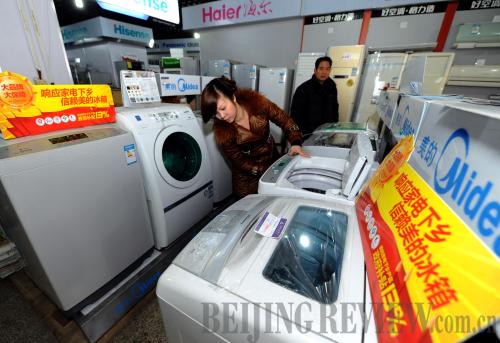|
 |
|
SHOPPING SPREE: Shoppers in Minhou County of southeast China's Fujian Province browse home appliances. Subsidized sales following the government's "home appliances to the countryside" project reached 1.5 billion yuan ($223.5 million) in 2009 (ZHANG GUOJUN) |
The Chinese economy owes its success and survival from the economic meltdown to the series of responsive Central Government stimulus projects initiated in 2009. And as the new year progresses, the government's responses in the past year can be used to cast a positive outlook for the Chinese economy in 2010. Zheng Xinli, Vice Chairman of the China Center for International Economic Exchanges, offered his insights at the First Annual Meeting of the Chinese Economy held on January 17 in Beijing. Edited excerpts follow:
Last year, the world economy faltered amid the most serious economic crisis since the Great Depression. Even though some countries have been able to rally their economies, the world's major economies, in the long run, will undergo a long, drawn-out process in their recoveries that will most likely feature significant adjustments to their economic policies.
The sweeping financial crisis posed many challenges to China and its economic development in 2009, with the economy showing the following characteristics:
A higher growth rate was scored in the second half of the year than in the first half. Data collected throughout the year showed a V-shape recovery.
While the economic rally last year was largely propelled by investment, gratifying changes took place in domestic consumption.
Commodity prices remained low whereas asset prices saw a rapid increase.
Unemployment was fundamentally mitigated and employment, especially for migrant workers, improved dramatically.
Exports suffered from decreases, but a rebound is at hand.
The banking system stayed fit, laying a solid foundation for the economic haul.
The Chinese economy's rapid recovery was mainly attributed to the government's stimulus measures.
Unfavorable factors handicapping the Chinese economy still exist, from the economic pick-up's dependence on investment to the calls for further adjustments to the economic structure, as well as the low proportion of residential income compared with total income, the prevalence of overcapacity, potential pressures on the finance, and greater stress on the banking system due to credit defaults, especially growing risks for local government loans.
Outlook in 2010
Only if the current proactive fiscal policy and moderately easy monetary policy continue, will the Chinese economy maintain a steady and comparatively rapid growth rate this year.
To be more specific, the Chinese economy will score a higher growth rate in the first half of this year than in the second half. The annual GDP growth is expected to reach 9 percent. The growth of investment will remain high, but may experience a slowdown compared to 2009. The growth for fixed assets is expected to exceed 20 percent this year.
Consumption will see a rapid growth and play a relatively steady role in promoting economic development. It is expected to account for 4 percent of the annual GDP growth.
Foreign trade will improve and play a positive role in driving up economic increases, with imports expected to rise by 13 percent and exports by 10 percent year on year.
Industrial production will continue to grow along with the adjustment of the industrial structure in line with demand changes.
Commodity prices will stay stable whereas production materials and some industrial goods will face mounting pressures as prices increase. The consumer price index is expected to reach 3 percent and the producer price index 5 percent.
| 